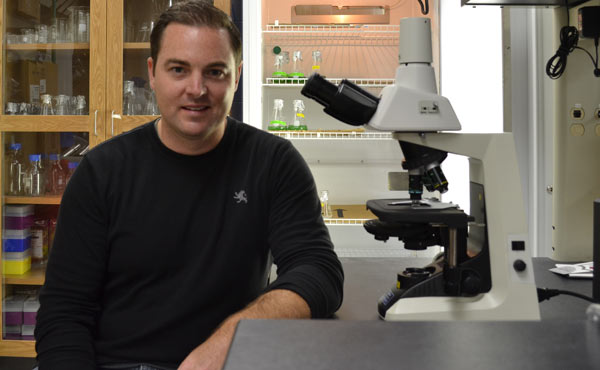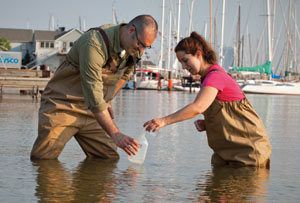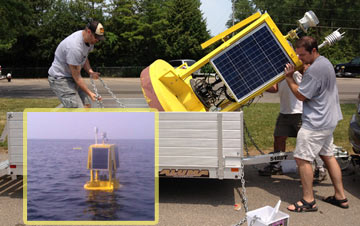
A University of Wisconsin-Milwaukee faculty member and a team of students have been working with the Milwaukee Health Department to study the health of Milwaukee’s beaches and the surrounding water.
“We have an army of students who want to get out and participate in the practical side of public health,” says Todd Miller, assistant professor of environmental and occupational health in the Joseph J. Zilber School of Public Health. “This is something that really has an impact on the community.”
Clean water is a key part of public health, explains Miller, who works with his team at the Laboratory for Aquatic Environmental Microbiology and Chemistry.

“The thrust of the lab’s work is looking at how toxic chemicals – either natural, like blue-green algal growth fed by phosphorus and other factors in lakes, or manmade, like those created from personal-care products and the anti-microbials in those products – affect the quality of water.”
The lab’s researchers are also looking longer term at ways to improve wastewater treatment so that more of these toxins are removed.
The students involved with the project appreciated getting the experience.
“I think it was awesome,” says Dani Oluwatosin, a first-year student who worked with Miller’s lab as part of an undergraduate research experience this summer. “It was great to get hands-on experience.”
Building a water-quality database
In addition to providing students to help augment the Milwaukee Health Department’s testing for sewage contamination, Miller says, the researchers would also like to start building a database of information that might help forecast when beaches are likely to be affected by contamination.
“Taking a water sample and testing it can take up to 18 hours. If we could develop a database of information that can be retrieved easily, we could develop a forecast model. We hope that other cities, like Racine and Kenosha, would be able to fit their data into our database, in effect creating a snapshot of lake quality.”
This water-quality database will involve a collaboration between Miller and his team, who will do the field research, and Professor Peter Tonellato and his research team at the Zilber School’s Laboratory for Public Health Informatics and Genomics.
“The ultimate goal is to find better ways to determine when contamination is making beaches unhealthy, and doing something about it,” says Tonellato.

Miller and his research team are also looking at other types of contamination in drinking water, including how certain types of chemical pollutants are broken down and transformed in water. Some of the resulting products may be more harmful than the original chemical compounds, and have been linked to certain types of cancers, he says.
The researchers are also looking at improving methods for monitoring algal blooms on freshwater lakes, like Lake Winnebago in central Wisconsin, and reducing human exposure to their toxins. These blue-green algae blooms – fed by warm weather and chemicals in the lake – are a constant problem, impacting both water quality and public health, according to Miller
The impact of anti-microbial ingredients from personal-care products on water quality is also a public health concern, he adds, as these products are flushed into rivers, lakes and streams.
“These anti-microbials are very hard to detect in drinking water. We want to see if there is any impact on people who drink them in the water, and find ways to prevent their occurrence in drinking water. Another worry is that these may end up in food, since sewage sludge can be made into fertilizer, and 64 percent of it is applied to agricultural land.”







